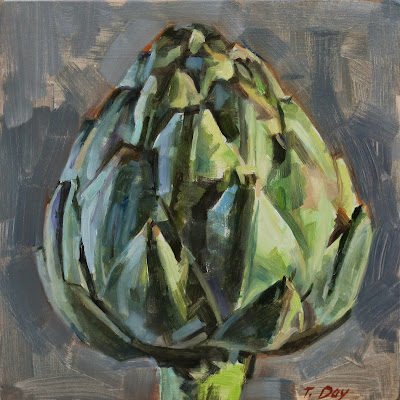Artist's Tips and Tricks- a Blog Carnival!
Today a group of six painters are blogging about some of the tips and tricks of our trade. I'm putting a special emphasis on my approach to painting from digital images.
You can click on these other five artists to gather more helpful tips:
I've been painting from life for more than thirty years, but in the last two years have developed a method for painting from my own digital images that doesn't scream "this was painted from a photograph!"
I enjoy working from photographs because the practice has opened up subject matter possibilities to an amazing degree. Many people ask me if I work from life or not, even when I paint a pose that would be impossible for someone to hold, like this:
A photograph or digital image gives too much information, and at the same time, not enough. There is too much information about detail, with edges gaining an importance they don't have in real life. There is not enough information about color, and the shadows are too dark, and the lights too light.
The temptation is to paint with a tiny brush, trying desperately to capture everything seen in the photo, but you have to use some smarts or the photograph will conquer you.
Here are six of my main "tips and tricks" for working from a digital image:
1. Choose an image that has strong value contrast. Using your computer's photo editing program, view the image in black & white. If the image is still compelling, it will work well in color.
2. Print out the image in black and white. With the use of a grid, draw the composition on your panel upside down (more on that in a minute). Keep this print out next to your panel or canvas while you paint, and constantly check it for the correct values. Getting the correct values trumps getting the right color.
3. Paint from your computer monitor, and always with the image upside down. That's the best way to forget the subject, and to trick your mind into putting less importance on concrete information like "this child has a nice smile", and more on pure shape, line and color. It's the best way to keep your focus on the abstract qualities of a subject, which will help your painting look less stiff and photographic.
Every now and then you can turn your painting over to get a very fresh look at your progress. I set my painting on a shelf in another area of my studio, and always view it from several feet back. If it doesn't look good from a distance, it won't be a strong painting.
4. When you work in a shadowed area, use your photo-editing program to temporarily lighten it. Having deep shadows with little infomation will make your painting look overly photographic. Darken your image when working on the most strongly lit areas. Backlighting is beautiful, but you have to continually adjust the brightness to make it work.
5. Use a variety of brush sizes, using the smaller ones for an area you want to focus on, and larger ones for summing up an area. If part of the scene is overwhelming in detail, move ten feet back from the computer to work on it, and try squinting. Getting way back is the best way to see the scene as a whole, and will help your work to not look overly tight.
Utrecht's series 239 mixed synthetic Brights are great for details and Princeton Brush Series 6300B work well for working more loosely.
6. If you wear glasses, now and then take them off while you paint. If an area is giving you trouble, especially if it is a face, paint it upside down and without your glasses and you'll be amazed at how much easier it is to get a likeness.
So there you have it, six quick tips that I've spent years figuring out. Hope it was helpful! If you'd like more detailed information about my approach to working from digital images, you can visit my
ArtByte shop.
You can click on these other five artists to gather more helpful painting-related tips:





.jpg)






































